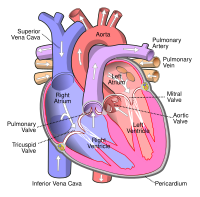
Photo from wikipedia
A 58-year-old Chinese male with past medical history of hypertension, hyperlipidaemia and ischeamic cardiomyopathy (left ventricular ejection fraction: 30%) presented to our hospital with 3 days of cough, fever and… Click to show full abstract
A 58-year-old Chinese male with past medical history of hypertension, hyperlipidaemia and ischeamic cardiomyopathy (left ventricular ejection fraction: 30%) presented to our hospital with 3 days of cough, fever and haemoptysis (small streaks of blood). Chest X-ray (CXR) performed demonstrated right lower zone airspace opacities which could represent infective changes or haemorrhage (Fig. 1a). The patient was treated with antibiotics and discharged a week later. However, the haemoptysis did not improve and gradually worsened over the next few months. Patient was coughing out approximately 3–4 mL of blood per day and his vitals on readmission were as follows: BP 157/81, RR 20/min, PR 102 and SpO2 95% on room air. A repeat CXR (Fig. 1b) demonstrated a peculiar rim-calcified density below the aortic arch which was missed on the initial CXR. Further investigation with a contrast-enhanced computed tomography scan (CT) demonstrated a large 3.0 × 3.2 × 2.9 cm mediastinal bronchial artery aneurysm (BAA) (Fig. 2). The aneurysm was arising very close to the aorta and had a very short vascular neck (2–3 mm). The case was discussed at multi-disciplinary meetings and decision was centred over an endovascular option in view of the surgical risks. The patient was on dual antiplatelet therapy and this was stopped 5 days prior to procedure. The patient then successfully underwent coil embolization of the aneurysm at our hospital. Vascular access was obtained through the right femoral artery via a 4-Fr vascular sheath. Cannulation of the bronchial artery was performed with a 4F Sim 1 catheter. A Progreat microcatheter (Terumo Interventional Systems) was then used to cannulate the BAA. Coil embolization was performed using Boston Scientific detachable Interlock coils (sizes 12–2 mm, lengths 20–60 cm). A total length of 5 m of coils were deployed into the aneurysm. Completion angiogram demonstrated successful exclusion of the aneurysm with no significant blood flow into the efferent bronchial artery (Fig. 3). Follow-up CT obtained 3 months after procedure (Fig. 3) revealed that the aneurysm has remained stable and the patient remained in good health 4 months post procedure. The patient was restarted on antiplatelet therapy by the primary team 3 weeks after the embolization. BAA are rare (<1% of all patients who underwent selective bronchial arteriography). They can be located intrapulmonary, within the mediastinum or both. BAAs are commonly associated with chronic lung diseases such as cystic fibrosis, bronchiectasis or tuberculosis. They are potentially dangerous because of its predisposition to rupture. Patients usually present with haemoptysis, but a wide range of symptoms are possible secondary to extrinsic compression of adjacent structures from BAA. In our case, the patient had no history of chronic lung disease. Upon further questioning, he recalled a previous history of significant deceleration history during a road traffic accident 8 years ago. We believe the BAA could be a result from blunt thoracic injury due to the road traffic accident. There are currently no guidelines available in management of mediastinal BAAs. Decision on the ideal therapy is confounded by the variability in location of the aneurysm within the mediastinum and morphology of the aneurysmal sac. Historically, surgical option was preferred for mediastinal BAAs with short vascular necks while endovascular embolization was used to treat mediastinal BAAs with appropriate length of bronchial artery proximal to the aneurysm. Advances in endovascular techniques have however led to a recent change in treatment planning. There are few case reports demonstrating successful embolization of mediastinal BAAs with short vascular necks. The treatment involved using coils, stent-grafts or a combination of both. In this case, we used detachable coils to embolize the aneurysm. Detachable coils allow accurate placement of coils, reducing catastrophic
Journal Title: ANZ Journal of Surgery
Year Published: 2019
Link to full text (if available)
Share on Social Media: Sign Up to like & get
recommendations!